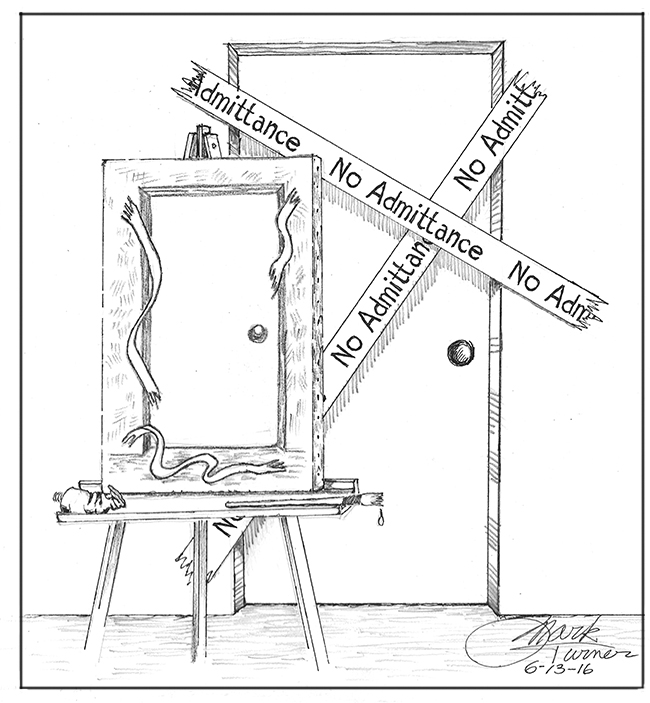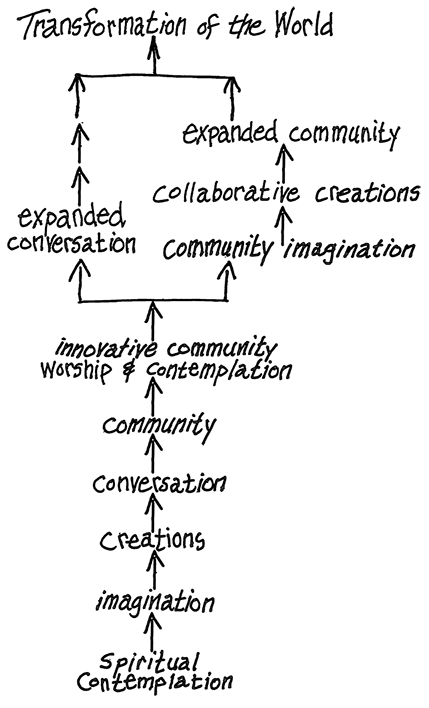
Walter Brueggemann has said that artists and poets call us to imagine the world differently. Ideally, artists and poets present us with perspectives outside our established routines and systems, outside our ideologies of protection, denial, privilege and exceptionalism. They call us to wait and listen, to ponder, to return to the imaginative; imagine a place better than here and now; imagine getting up and going there.
How Art and Poetry are Neutralized
Such a call is often muffled, or rejected outright in order to maintain an equilibrium which has been achieved by great investment. Poets and artists are tolerated within the limits set up for them: galleries, museums, economic restrictions, approved institutions, hierarchies that allow only a select few to achieve visibility. The arts and poetry tend to be exalted away from practical reality by high prices and privileged surroundings which keep them aloof and removed. Artists and poets who make people feel good are rewarded and those who present disturbing art and poems are shunned. In another twist, disturbing art and poems can also be inoculated by being commodified and given status as a genre until they are valued only because they are “disturbing;” the audience can always just walk away after a good scare. Often the arts and literature are eliminated for expedience in favor of things which more quickly shore up the equilibrium, i.e.: we need more scientists and pragmatic workers.
Equilibrium does not want to be told about alternatives, or better states of being. So, in order to limit disturbances, artists and poets are often denied their role as “seers” and prophets. They are obliged to either be “subversives” calling from outside the boundaries, or work within sanctioned guidelines.
Art and Poetry Know When to Move
What equilibrium does not want to hear about is change. But humans ultimately crave change because we are innately creatures of growth. Static equilibrium might be a peaceful respite after a chaotic period, but that very equilibrium was achieved through creative people imagining solutions. We want to preserve that achievement, to camp there on the mountain top. Artists and poets seem to be among the first to feel stagnancy and cry out for variety, to change assumptions which no longer serve. They realize we have not arrived in utopia and call out as Jesus often did, “Get up. Let us go from here.”
But, we hope the seers will call us with authentic inspiration; “Please don’t mislead us. How will we know?”
Steps Toward Transformation
Art and poetry resist definition, but let’s put them in the context of our life together.
Imagining is the seed within us of that which could be. An artist’s capacity to invent a progression, to envision what is not and create it, is complicated by the range of values in their inner person, let alone the value ranges in the souls of everyone else. If the heart is self-centered, revengeful and combative, the imagining will tend toward visions of destruction. If the heart is considerate of others, healing oriented and peace making, the imagining will tend toward visions of constructive progress. How does one get a heart that leads upward and forward and not revert to destruction?
- Nurturing a contemplative life focused on the Spirit will engender an imagination of growth.
- The imagination so focused reveals God in the various ways we perceive the world.
- Representing those revelations in artifacts, sights and sounds ignites conversation between people.
- The conversations around those representations forms interpersonal bonds which germinate communities of creators.
- Such communities expand conversation and collaboration to multiply the objects and deeds revealing God in the material world.
- In this way God’s incarnation of us and manifestation through us transforms the world onward in the eternal progression God has built into creation.
So, art and poetry show that the on-going, daily disciplines and practices of life could flow upward something like this:



Tricia
Great insights, outlined clearly in your graph of creation being grounded in spirituality and leading to community. I want to keep “getting up and going there” but I need help from my friends!
markart
Thanks, Tricia — Somehow the conversation needs sparking and stimulating as we go along. I hope to apply myself to contribute more stimulants than I have so far. Thanks for receiving them and for those you send out as well.
Kirby
I was struck by the similarities between prophets and poets and artists. All are cofined to their boundaries where they don’t shake up everyone’s comfort zone.
I am pondering your plan for transformation, Mark. I definitely agree that renewal begins with the individual.
Thank you for such a challenging plan!
markart
Thank you, Kirby — None of us can fulfill that progression alone. Let’s keep encouraging one another to keep making our expressions of God and gather around them for the conversation that builds loving, growing, transforming community. That’s our part and God’s creation progresses through us.
Kathleen Thompson
So elegantly put Mark and it’s so encouraging to read such a thoughtful statement of it. Thanks!
markart
Thank you for reading and thinking, Kathleen. I pray we can all be encouraged to keep creating and making expressions that spark the kind of conversation which draws all upward in God’s progression.